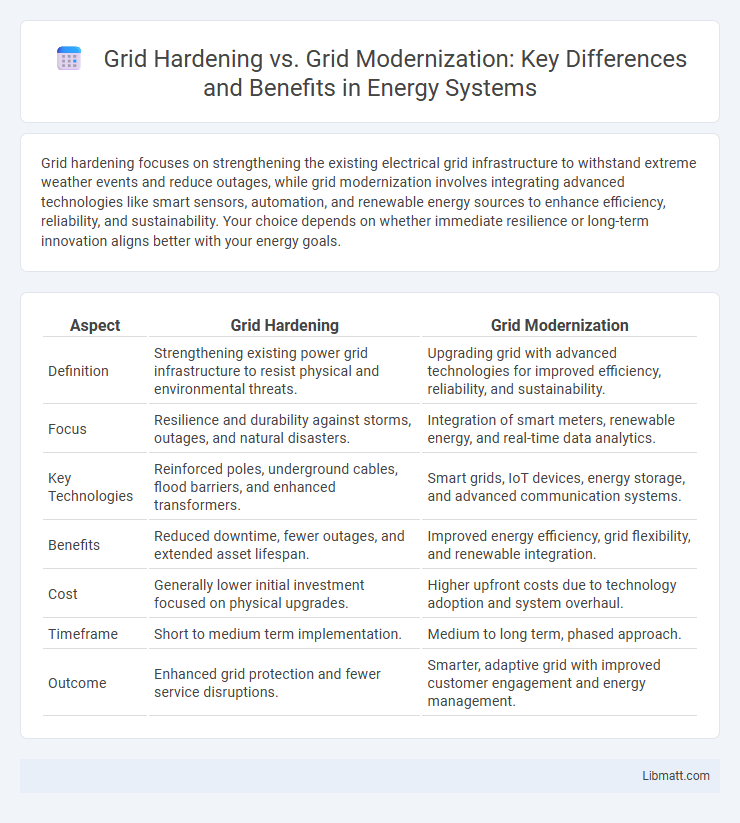Grid hardening focuses on strengthening the existing electrical grid infrastructure to withstand extreme weather events and reduce outages, while grid modernization involves integrating advanced technologies like smart sensors, automation, and renewable energy sources to enhance efficiency, reliability, and sustainability. Your choice depends on whether immediate resilience or long-term innovation aligns better with your energy goals.
Table of Comparison
| Aspect | Grid Hardening | Grid Modernization |
|---|---|---|
| Definition | Strengthening existing power grid infrastructure to resist physical and environmental threats. | Upgrading grid with advanced technologies for improved efficiency, reliability, and sustainability. |
| Focus | Resilience and durability against storms, outages, and natural disasters. | Integration of smart meters, renewable energy, and real-time data analytics. |
| Key Technologies | Reinforced poles, underground cables, flood barriers, and enhanced transformers. | Smart grids, IoT devices, energy storage, and advanced communication systems. |
| Benefits | Reduced downtime, fewer outages, and extended asset lifespan. | Improved energy efficiency, grid flexibility, and renewable integration. |
| Cost | Generally lower initial investment focused on physical upgrades. | Higher upfront costs due to technology adoption and system overhaul. |
| Timeframe | Short to medium term implementation. | Medium to long term, phased approach. |
| Outcome | Enhanced grid protection and fewer service disruptions. | Smarter, adaptive grid with improved customer engagement and energy management. |
Introduction to Grid Hardening and Grid Modernization
Grid hardening involves reinforcing the electrical grid infrastructure to withstand extreme weather events and reduce vulnerability to physical and cyber threats, ensuring reliable power delivery. Grid modernization focuses on integrating advanced technologies like smart meters, distributed energy resources, and real-time data analytics to enhance grid efficiency, flexibility, and sustainability. Both approaches aim to improve grid resilience but through different strategic methods targeting physical robustness and technological innovation.
Defining Grid Hardening: Purpose and Strategies
Grid hardening enhances the electrical grid's resilience by strengthening infrastructure to withstand physical and cyber threats such as extreme weather events and cyberattacks. Key strategies include upgrading poles and transformers, undergrounding power lines, and improving cybersecurity measures to reduce outage risks and accelerate recovery. These targeted investments ensure critical grid components remain operational during disruptions, minimizing service interruptions and safeguarding public safety.
What is Grid Modernization? Key Concepts
Grid Modernization involves upgrading the electrical grid with advanced technologies to improve reliability, efficiency, and integration of renewable energy sources. Key concepts include smart grid technologies, real-time data analytics, distributed energy resources, and enhanced cybersecurity measures. Your energy system benefits from increased resilience, adaptive control, and improved demand response capabilities through these modernized infrastructure improvements.
Comparing Grid Hardening and Grid Modernization
Grid hardening involves reinforcing electrical infrastructure to withstand extreme weather events and physical damage, focusing on reliability and resilience. Grid modernization emphasizes integrating advanced technologies such as smart meters, automation, and renewable energy sources to enhance efficiency and flexibility. Comparing the two, grid hardening prioritizes durability and protection, while grid modernization aims to optimize performance and enable a more adaptive energy system.
Technologies Driving Grid Hardening
Advanced sensors, fault detection systems, and automated switches are key technologies driving grid hardening by enhancing the grid's resilience against physical and cyber threats. Technologies like distributed energy resources integration and microgrids also contribute to reinforcing the grid's ability to withstand extreme weather events and reduce outage durations. Strengthening critical infrastructure with hardened transformers and underground cabling further supports the durability and reliability of electrical distribution networks.
Innovative Solutions in Grid Modernization
Grid modernization incorporates innovative solutions such as advanced sensors, automated controls, and real-time data analytics to enhance grid reliability and efficiency. Integration of distributed energy resources (DERs) and energy storage systems supports a more resilient and flexible grid infrastructure. These technologies enable dynamic load management and predictive maintenance, significantly improving grid performance compared to traditional grid hardening methods.
Benefits and Limitations of Grid Hardening
Grid hardening enhances infrastructure resilience by reinforcing physical components against extreme weather, cyberattacks, and equipment failures, thereby reducing outage frequency and duration. It improves reliability and safety but often involves high upfront costs and may not address evolving technological demands or integrate renewable energy sources effectively. Limitations also include potential inflexibility and slower adaptation to smart grid innovations compared to broader grid modernization efforts.
Advantages and Challenges of Grid Modernization
Grid modernization enhances energy efficiency and reliability by integrating advanced technologies like smart meters, renewable energy sources, and automated controls. However, challenges include high upfront costs, cybersecurity risks, and the need for regulatory updates to support new infrastructure. Your energy system benefits from increased resilience and real-time data, enabling better demand management and reduced outages.
Case Studies: Grid Hardening vs. Modernization in Action
Case studies reveal that grid hardening prioritizes physical infrastructure strengthening, such as reinforcing poles and undergrounding lines, while grid modernization integrates smart technologies like advanced sensors and automated controls for increased resilience and efficiency. For example, after Hurricane Sandy, New York invested heavily in grid hardening to withstand storms, whereas California's smart grid projects focus on modernization to optimize energy distribution and support renewable integration. Understanding these outcomes can help you determine whether hardening or modernization aligns better with your grid resilience and sustainability goals.
Future Outlook: Integrating Hardening and Modernization
Grid hardening strengthens infrastructure against physical and cyber threats by reinforcing equipment and enhancing resilience, while grid modernization focuses on incorporating smart technologies and advanced digital controls for improved efficiency and adaptability. Integrating hardening and modernization creates a robust, flexible energy network capable of withstanding extreme weather events and evolving energy demands. Future smart grids will leverage real-time data analytics, distributed energy resources, and automated controls to optimize reliability and security simultaneously.
Grid Hardening vs Grid Modernization Infographic

 libmatt.com
libmatt.com